Student Success Through our Personal Growth Plan
For students, navigating the complexities of education, social relationships, and emotional regulation can present unique challenges. However, we see our students thrive when given the right tools and structure. One such tool is the Personal Growth Plan (PGP), which offers a clear path for progress across six key areas: Academics, Wellness, Interpersonal Relationships, Executive Functioning, Emotional Regulation, and Independence and Initiative. Through a series intentionally designed steps, this plan helps students develop and hone the skills necessary for success in school and life.
Let’s explore how students succeed by moving through the steps of the PGP, with the ultimate goal of becoming confident, self-sufficient individuals who can interact with peers, family, staff, and the broader community and successfully navigate school and life challenges.
The Six Core Competencies
The foundation of our Personal Growth Plan is based on six core competencies that provide students with the skills they need to thrive:
1. Academics:
Students develop engagement with their coursework, improving their academic skills, focus, consistency, and goal-setting abilities.
2. Wellness:
Students learn to care for their physical, emotional, and mental well-being, recognizing the connection between health and wellness.
3. Interpersonal Relationships:
Students develop social skills, including communication, understanding social cues, and deepening their connections with others.

4. Executive Functioning:
Students gain skills in planning, organizing, and managing time and tasks to improve efficiency and effectiveness.
5. Emotional Regulation:
Students learn to identify and manage emotions, fostering better-coping strategies and resilience.
6. Independence and Initiative:
Students work towards being proactive, self-motivated, and able to work independently while seeking help when needed.
The Five Steps of the Personal Growth Plan
The Personal Growth Plan is structured around five steps, each designed to build on the previous one, allowing students to move at their own pace while meeting expectations and completing tasks that support their growth.
1. Orientation
Our goal in the beginning is to introduce students to our team, their peers, and our process. Students build relationships with our team and familiarize themselves with the expectations of the Personal Growth Plan and are introduced to the six core competencies. During this step, students reflect on their strengths and challenges and begin to identify areas they would like to improve. They are given the tools and structure needed to succeed in the next steps of the plan. This step is crucial for setting a positive tone and building a sense of agency in the student’s personal development journey.
2. Self-Assessment and Goal Setting
Once students understand the core competencies, the next step is self-assessment. Students take time to evaluate their current strengths and areas for growth. Based on their self-reflection and work with staff, they set specific, measurable, and attainable goals for each competency. Whether improving academic engagement, enhancing emotional regulation, or developing social skills, setting clear goals empowers students to take ownership of their progress. This step builds self-awareness and helps students see the value of taking small, incremental steps toward long-term success.
3. Action and Practice
Students begin to take concrete actions toward achieving their goals in this step. They engage in specific tasks and activities designed to strengthen the skills associated with each core competency. For example, a student might practice mindfulness exercises or go for a brief walk to improve emotional regulation. They might participate in group discussions or introduce themselves to someone new in the community to build interpersonal relationships. Success in this step is measured by how consistently students complete tasks, apply strategies, and practice skills. The focus is on action, trial, and error, creating opportunities for students to practice their social and academic skills in real-world situations.
4. Maintenance and Refinement
As students progress, the focus shifts to maintaining the skills they’ve developed while refining their abilities. In this step, students build upon their progress by reinforcing positive habits and behaviors. For example, they might refine their academic study routines or develop more effective emotional regulation techniques. One focus is helping our students refine their ability to self-advocate more effectively with their parents and our team during this step. The goal is to build consistency. Students are encouraged to review their goals regularly to ensure they stay on track and improve where needed. By maintaining their progress, students gain a sense of mastery over their skills, which boosts their confidence and positive momentum.
5. Independence and Generalization
The final step is focused on achieving independence. Students work towards demonstrating their skills and forward progress without the need for constant guidance from their parents and staff. At this point, they are expected to generalize the skills they’ve learned to various settings and situations, including at school, with peers, at jobs, and within their families and our community. This step marks a significant milestone in the student’s development, as they are not only meeting goals but also contributing to their success now and long-term.
Benefits of the Personal Growth Plan
The Personal Growth Plan offers numerous benefits for students. One of the primary advantages is that it helps students move through each step at their own pace, allowing them to gain confidence and mastery over time. As students progress through their goals, they are better equipped to manage their academic workload, engage in meaningful social relationships, and regulate their emotions. These improvements extend beyond the classroom and into real-life situations, where students can interact more successfully with peers, family members, staff, and the broader community.
Building Relationships and Social Skills
A key focus of the Personal Growth Plan is the development of interpersonal relationships. Through guided practice, students can develop the social skills they need to build and maintain friendships. This includes learning to navigate social situations, understand social cues, and communicate effectively with others. As they practice these skills, students become more confident in social interactions, leading to deeper relationships with peers, family, and staff.
Academic Engagement and Consistency
Through the Personal Growth Plan, students also learn to engage more effectively with their academic work. The focus on executive functioning helps students develop skills in time management, organization, and task completion. As students make progress, they become more consistent in their efforts, improve their academic performance, and learn to set and achieve educational goals.
Emotional Regulation and Self-Reflection
As students work through the Personal Growth Plan, they also increase their ability to self-reflect and regulate their emotions. Emotional regulation is crucial for managing the stress and challenges of academic life and social interactions. By identifying their emotions and learning coping strategies, students become more resilient and self-aware, which can lead to more successful and fulfilling experiences.
Conclusion
The Personal Growth Plan is a powerful tool for helping students develop essential life skills. By progressing through orientation, self-assessment and goal setting, action and practice, maintenance and refinement, and independence and generalization, students gain the skills necessary to succeed academically, emotionally, and socially. As they build relationships, improve their academic engagement, and develop strong self-regulation and independence, they are better equipped to meet the expectations of their environment. With patience, practice, and dedication, students thrive and achieve their full potential.
Brandon Moffitt, LCMHC, Executive Director

